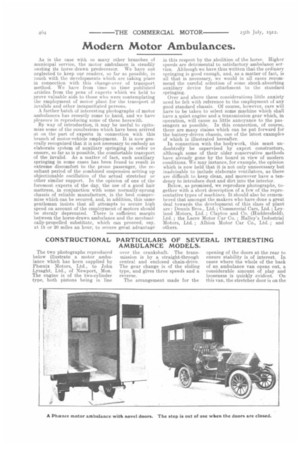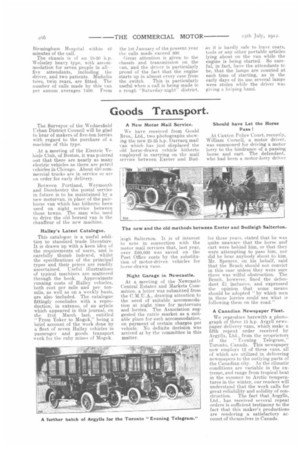CONSTRUCTIONAL PARTICULARS OF SEVERAL INTERESTING AMBULANCE MODELS.
Page 4

Page 5

Page 6

If you've noticed an error in this article please click here to report it so we can fix it.
The two photographs reproduced below illustrate a motor ambulance which has been supplied by Phoenix Motors, Ltd., to John Lysaght, Ltd., of Newport, Mon. The engine is of the two-cylinder type, both pistons being in line
over the crankshaft. The transmission is by a straight-through central and enclosed chain-drive. The gear change is of the sliding type, and gives three speeds and a reverse.
The arrangement made for the
opening of the doors at the rear to ensure stability is of interest. In cases where the whole of the back of an ambulance van opens out, a considerable amount of play and looseness is quickly evident. On this van, the stretcher door is on the
left-hand side, and, while extending as low as is necessary, has the advantage of leaving a portion of the coachwork below the door as a permanent brace, while the righthand door is so arranged as to leave the remaining portion of the body clear of obstacles. The step is conveniently held out of use when the right-hand door is closed. Ample accommodation is provided for the insertion and removal of the stretcher, and, on the right, will be seen the attendant's seating arrangement. The window in the front enables the attention of the driver to be called at once in case of need. To the right of the front window will be noticed a cupboard for the accommodation of first-aid appliances. The price of the ambulance, complete with four lamps, horn and number plates, is under 2300. This price should ensure a considerable number of orders.
Thc illustration herewith of an electric ambulance concerns a Cedes battery-driven vehicle which has recently been supplied to the Port of London Authority, and for which Messrs. Markham and Prance have acted as consultants. The drive is by hub motors in the rear wheels, and the position of these is shown in our illustration. Either motor can be cut out if required, and we are assured that the vehicle runs perfectly well with one motor. The control provides for four speeds forward and a reverse, and a top speed of 18 miles an hour can be obtained. The battery is of a special traction type, carried under the chassis, and has a capacity of about 40 miles. With current at id. per unit, the ambulance can be run for a distance of about 40 miles for slightly under 2s.
By the kind permission of the Chief Constable of Birmingham, we are able to
reproduce photographs of this Midland city's motor-ambulance van. Our local correspondent recently spent a day with this vehicle, and went the rounds in the usual way and attended to all the calls that were given, which, incidentally, were very many. It is rather peculiar that a magnificently-equipped accident van such as this is should be placed at the services of " drunks ', without payment, whereas a private call costs is. 6d. An urgent call came in, as our photographer was focussing his camera in order to secure a photograph for reproduction in this journal. The call came from Acooks Green, a distance of six miles, and the patient was safely fixed in the
Birmingham Hospital within 40 minutes of the call.
The chassis is of an 18-20 h.p. Wolseley heavy type, with ace.ommodation for seven people in all— five attendants, including the driver, and two patients. Michelin tires, twin rears, are fitted. The number of calls made by this van per annum averages 1450. From
the 1st January of the present year the calls made exceed 800.
Great attention is given to the chassis and transmission on the van, and the driver is particularly proud of the fact that the engine starts up in almost every case from the switch. This is particularly useful when a call is being made in a rough "Saturday-night" district,
as it is hardly safe to leave coats, tools or any other portable articles lying about on the van while the engine is being started. So careful, in fact, have the attendants to be, that the lamps are counted at each time of starting, as in the early days of its use several lamps were stolen while the driver was giving a helping hand.






















